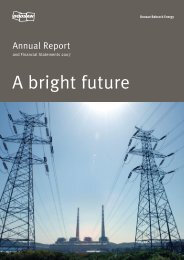Advanced Supercritical Boiler Technologies - Doosan Power Systems
Advanced Supercritical Boiler Technologies - Doosan Power Systems
Advanced Supercritical Boiler Technologies - Doosan Power Systems
You also want an ePaper? Increase the reach of your titles
YUMPU automatically turns print PDFs into web optimized ePapers that Google loves.
ULTRA SUPERCRITICAL – CYCLE OPTIMISATION<br />
• In addition to improvements in Rankine Cycle efficiency from increasing steam temperatures we can make<br />
better use of low grade heat in our power plant cycle<br />
• Feedwater heating can be optimised to reduce the quantity of high grade bled steam taken from the turbine<br />
and better utilise the low grade heat in the flue gas leaving the boiler<br />
SUMMARY<br />
• Increasing plant efficiency is fundamental to reducing all emissions including CO 2<br />
• Primary means to increase efficiency is to increase the steam pressure and temperature at the turbine<br />
inlet<br />
• This means using steam at supercritical pressures – we use terms such as “<strong>Advanced</strong> <strong>Supercritical</strong>” and<br />
“Ultra <strong>Supercritical</strong>” to indicate higher ranges of temperatures and pressures<br />
• We can make improvements to the basic once-through boiler concept like the Posiflow TM furnace to<br />
further increase efficiency and operating flexibility<br />
• <strong>Supercritical</strong> technology can be readily retrofitted to life-expired existing plant<br />
• Today’s <strong>Advanced</strong> <strong>Supercritical</strong> plant will achieve around 46-47% cycle efficiency (LHV basis) and about<br />
20% reduction in CO 2 for the same MWe output as existing sub-critical plant<br />
• Ultra <strong>Supercritical</strong> plant operating at steam temperatures above 700°C is the next step. Together with<br />
improved cycles this will achieve a plant efficiency over 50% and about a 30% reduction in CO 2<br />
compared to existing sub-critical plant<br />
• Attainment of 700°C is constrained by the availability of suitable materials for the highest temperature<br />
components and development programmes are underway<br />
Page 18<br />
Page 19<br />
10



